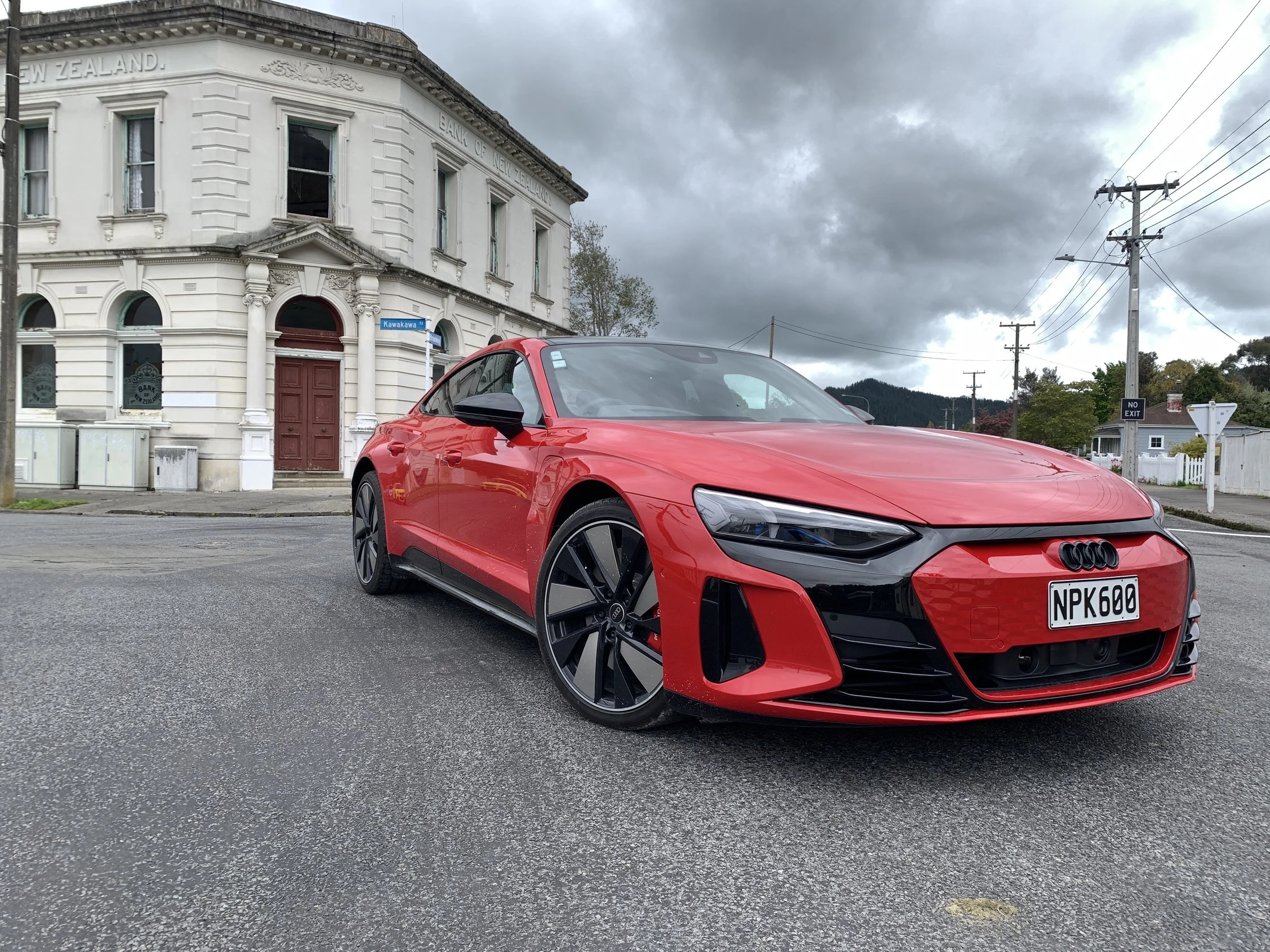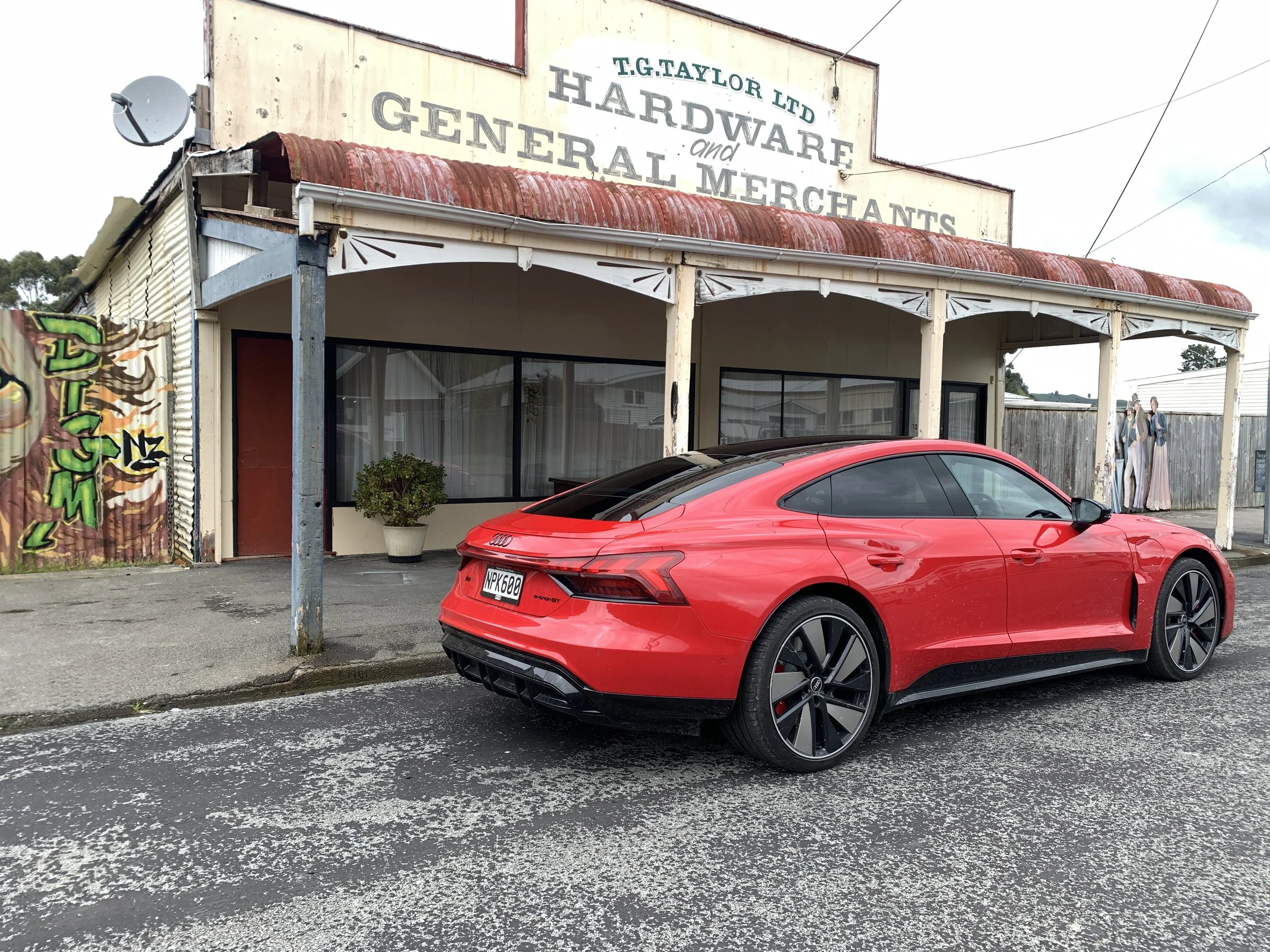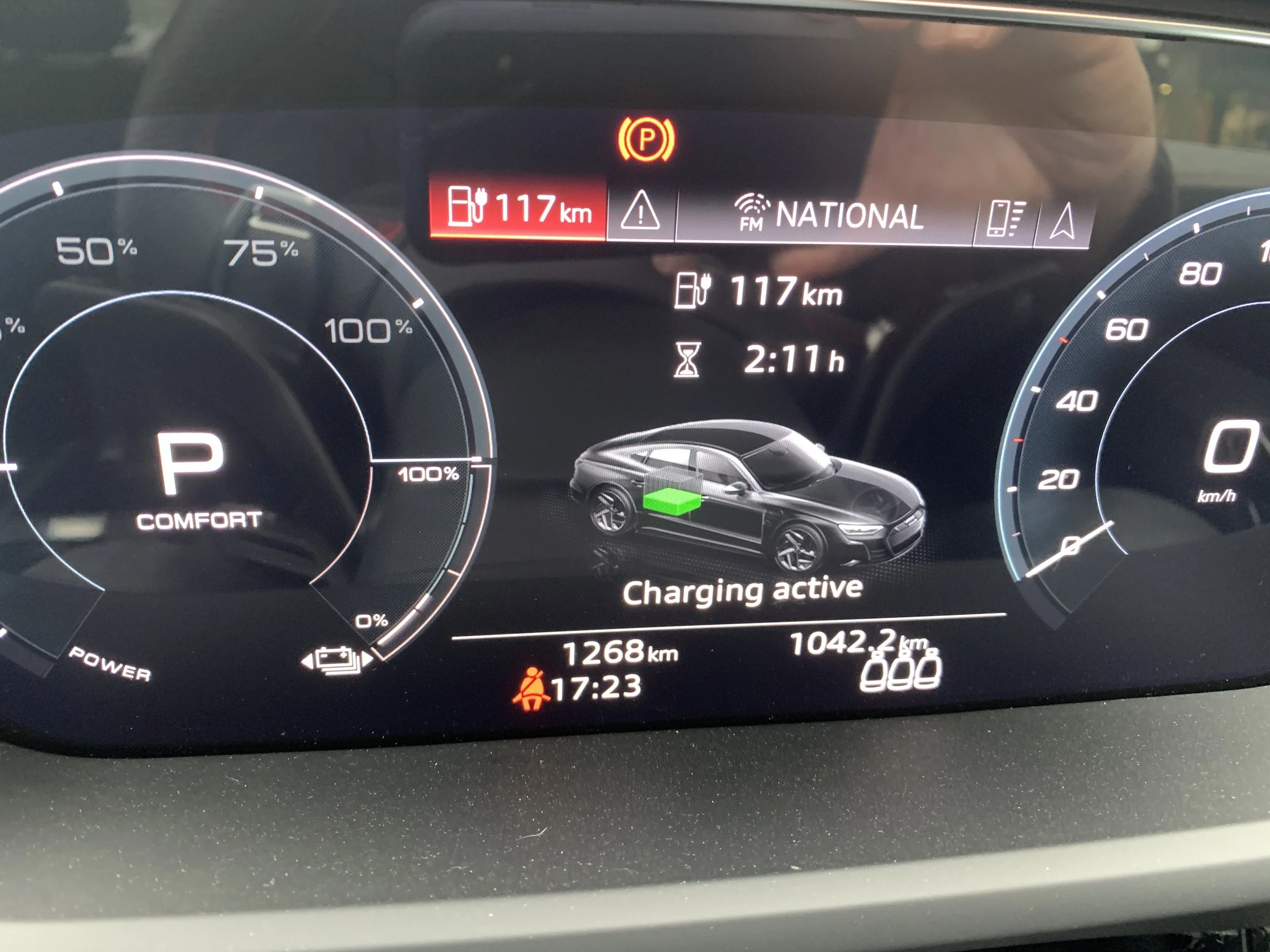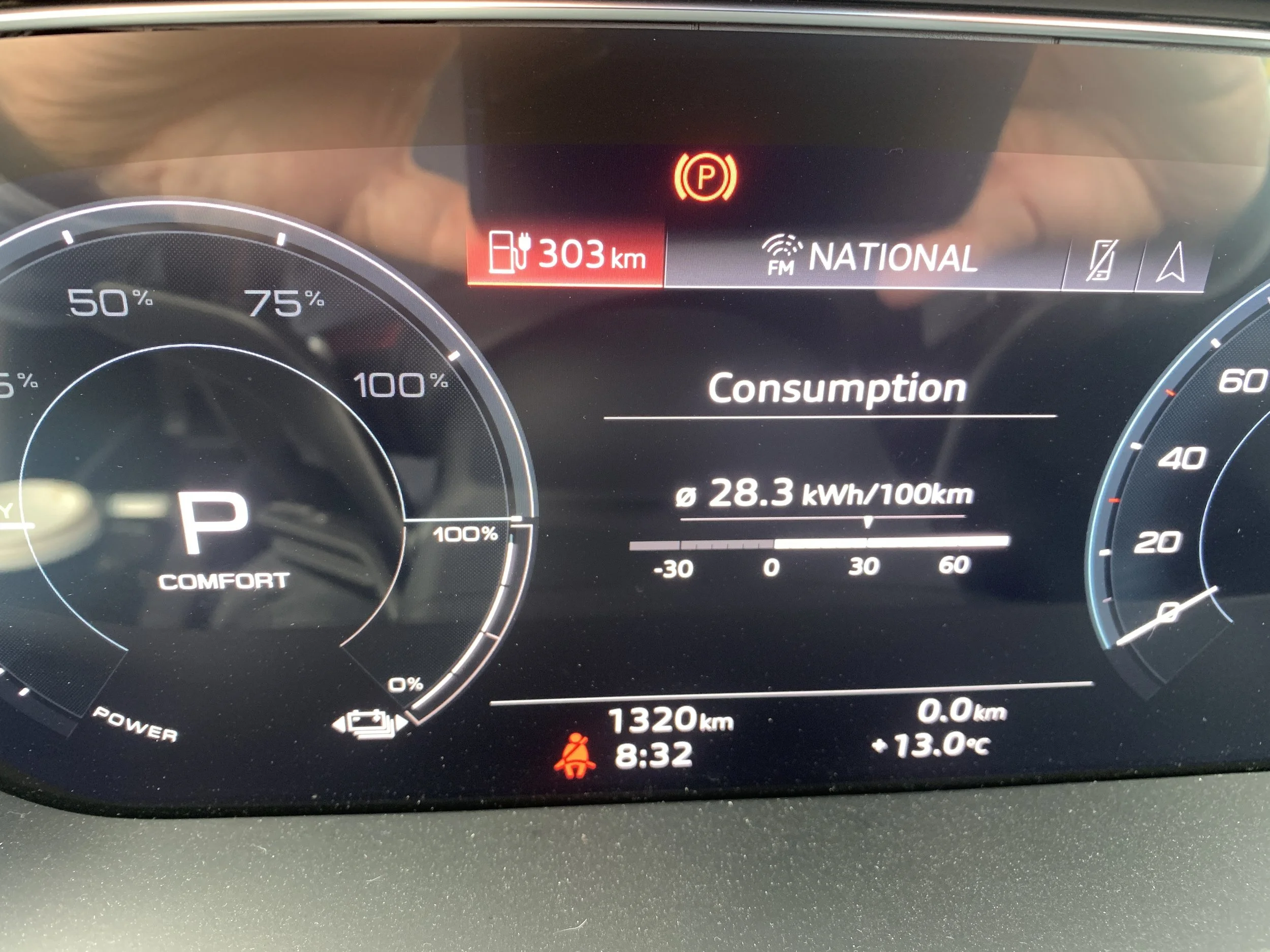Audi RS E-Tron GT review: Mean in green
/If an exciting electric car suits you, and you’ve got the deepest of deep pockets, this might be the best buy.
Price as tested: $282,550
Powertrain: Two permanent synchronous electric motors (front and rear) and a 92 kWh lithium-ion battery with 440kW/830Nm, 20.6 kWh/100km consumption, two-speed automatic transmission, AWD.
Vital statistics: 4990mm long, 1410mm high, 2158mm wide, 2990mm wheelbase; luggage space 405 litres (boot), 85 litres (bonnet).
Likes: Sharp looking, silent stonking go, un-RS-lke ride quality.
Dislikes: Slow charging on 50kWh network.
ENGAGING Porsche as a partner to help build a hotshot wagon worked well for Audi several decades ago; the RS2 (why no RS1? Good question) became the wickedest station wagon the world back then had ever seen - it even sniffed the McLaren F1’s exhaust in some take-off tests.
Now the band’s back together, working in a different era, with very different hardware and different challenges. This time, they’ve started not with anything existing but from scratch; each getting a new car different to any either has had before.
Audi’s e-tron GT and Porsche’s Taycan roll out as ground-hugging, lane-filling five-door five seaters. Apart from the J1/ Premium Platform Electric underpinning, common elements run to just 40 percent of components. So talk about Ingolstadt’s being a rework of Weissach’s is therefore unfair.
While one (and you can guess which), delivers with a bit more performance, and adds in a bit more pedigree – for a much higher price - that doesn’t mean the other is an understudy. The RS e-tron GT is as much a halo model as that first RS. Ingolstadt can be very proud.
It looks fantastic, just a touch sci-fi without being outlandish, is more practical than you'd expect given the slinky exterior and delivers with a whomping drivetrain fed by a large battery imbued with an advanced charging capability.
All of which, Audi believes, will make the transition from internal combustion engines to electric easier.
It’s a theory Kiwis could play a key part in proving, given our habit of buying more RS cars per head of capita. Conceivably that makes us a great measuring stick for Ingolstadt.
Certainty past buyers will automatically step up to this future is obviously a dice throw.
Performance is bonkers, yet so is the price. Asking big money for big bang is hardly a new thing for RS and Audi also makes no pretence about being a prestige player keen to set the standard by which other premium electric cars will be judged. Even so, this car is definitely one for the majority to admire, but never own. Still, I’d rather have one of these than any like-priced petrol model. Anything electric must stand to be so much better future-proofed.
In terms of buy-in, Audi has a big order base. It’d be nice to imagine this is the fanbase recognising now’s the time to swap their planet-damaging past playthings for cars with better eco standing. Yet it’s more likely it’s simply recognition that the future offers even more excitement than the big bangers of the past. Spoiler alert: It really does.
For sure, the ultimate test is how it drives – bear with on that – yet drawcard design is never a bad thing and it would be rude not to give the stylists some praise.
The base GT is an excellent example of how silhouettes and shaping can become so much more adventurous when there’s no need to locate a big lump of metal in the nose, but the RS treatment finesses all the more.
The extra embellishments associated with the performance sub-marque – enhanced here by a Black Optics package, which applies gloss black to the front and rear bumper trim, side skirts, and mirror caps - delivers an astounding automotive sculpture. That, a stance straight from the grid, the wide, R8-ish rear haunch ... just a glance gives you the shivers. BTW, it’s also one of the easiest cars to hand wash. Assuming you don’t have someone to do that.
Drawbacks? Aside from managing to cruelly date all oher Audi - including the ‘other’, sports utility, e-trons - you might find accessing enough of a gymnastic challenge to make you wonder if some might suffer for its art. Yet once they’ve eased inside – and perhaps found someone to help close the front doors, because they are a long reach - occupants will be relieved that the cabin proper is surprisingly roomy for something so slinky.
That’s down to a clever design trick enabled by the underfloor battery pack having built in footwells, which allows for the seats to be set lower. This means Audi can get away with a full-length panoramic glass roof without totally ruining the headroom.
Still, it’s clearly not a family car. Getting child seats in and out will likely prove challenging and the boot, while pretty big on paper, it’s hampered by the tight opening and is no place for a pooch pal. In respect to packaging provision, there’s a further 80-odd litres in the nose, providing space for the charge cables.
Given the car overall is so future-now, the cockpit will seem far too of the now to entertain having to find a silver space suit as driving wear. The interior is beautifully-trimmed, but doesn’t exactly gell with the drama when you're standing outside the car; it’s not conservative, but it is a touch austere, to be honest.
I’m not necessarily irked that Audi wasn’t bold enough to deliver a Tesla-matching yoke in place of a normal steering wheel, but Peugeot-esque 3D displays and i-Pace (and Ioniq 5)-like pop-out door handles surely could have been considered. Also, some of the smarty touches Audi does bring don’t work as well as they should. The covered centre console cubby has a side-attached wireless charger that is all but unusable if you have a fat phone.
Yes, there is considerable technology, almost all of which is generally easy to come to terms with. Basically everything is touch-activated on the main screen. Working out how to some of the finetune the EV-specific modes takes a bit of time; adjusting the battery charge limiter was initially a bit of a challenge. Yet it’s coherent enough that people unaccustomed to electric operability, let alone Audi’s way of doing displays, will fathom it.
Unplug and play is the order of the day. Press the start button, slip the gear selector – which is more a switch – into Drive and that’s it for making it go. No big roar, gorilla gurgle idle here. Just a faint electronic warble, as a pedestrian warning.
That is delivers little more aural thrill than a Nissan Leaf, not just when tooling around but also even at serious speed, should not be seen – as, actually make that heard – as a sign of weakness. The sound signature is just all part of electric life; but can actually be a boon when you’re demonstrating its punch. Full power take-offs without any kind of rolling thunder giveaway has it merits, I’ve decided. Say no more.
And when it goes … boy, does it GOOOOOOO! The e-tron GT is quite muscled enough, in that it features a motor on both front and rear axles which between them deliver 350kW, but that’s no enough for the RS badge and, of course, tradition demands anything in that club has to have so much more phwoar. As it does: You get 440kW in the go-even-faster model; or 475kW for a few seconds when you activate boost mode. So, the gruntiest RS ever, with an eye-poppingly quick off-line 0-100kmh sprint of just 3.3 seconds.
The launch control offers the best demonstration why this is considered the most brutal performance Audi available today, electric or internally combusted, and is the best way to impress pals new to EV and silence their sneers about the lack of sonic boom.
The action, obviously only recommended for use in suitable conditions, is childishly straightforward. The resulting wallop is, literally, a massive, primal gut punch. There’s no traction loss whatsoever; in one fluid moment it just hunkers then hurls itself forward with such huge brutality you wonder how it close it get to turning the rims within the tyres. When warp-speeding there’s a very slight mid-run hesitation as the drivetrain’s two-speed operation goes up a movement (you can’t really say ‘gear’). It’s a massive body-into-seat-back smash that perhaps only drag car aces and pilots who have flown off aircraft carriers might find familiar.
Though there are other EVs (the Taycan, at least one Tesla) that are even quicker off the mark, frankly, the Audi’s off-line experience is visceral and so gut-kicking discomforting in its own right that I now wonder whether being top trumps in this aspect is all it’s cracked up to be.
Just having so much grand slam oomph doesn’t make it a shoo-in to convince as being much better to drive than many of Audi's other largish performance cars. In reality, that conviction arrives more subtly – basically, driving on the Devil’s Thunderlight is just so massively different to hauling with Big Oil.
The car most like it in Audi’s combustion-engined range is the RS7, and even then that’s more through looking similar and offering the same kind of tarmac cling.
In respect to feel … that’s where there’s an interesting blend. Yes, RS is all about hard performance – even if the Taycan wasn’t a template (and Audi assures it wasn’t) it must have been a target. Yet Audi is frank in admitting it really isn’t intended for the race track. GT is shorthand for Grand Tourer and that also imprints on the way it gets around. The focus is therefore on effortless comfort around town and on the open road, as well as exuberant Sunday-morning performance on a twisty road. That’s a broader remit than that applying to many of its petrol products, then.
Broader … but better. What you get is an intriguing blend of talent. On the one hand, and despite its dimensions – especially the width – and the sheer weight of the thing, it imparts as a well-balanced, truly playful car of the sort of roads where petrol RS models simply come alive. The car’s frisky feel is abetted by the low-slung driving position; it’s basically putting your bum on the floor.
The electric does things quite differently in that scenario, though. You definitely have to alter your style to compensate for no engine braking into corners, but need always bear in mind it will deliver even more… erm … ‘electric’ acceleration out of them.
But you’ll love how keenly it turns in and be astounded how readily it holds any given line. Yes, I know, it has a lot of good gear. There’s the quattro ingredient and it runs very fat tyres, plus has a locking rear differential and massive tungsten-carbide coated brakes. But still … it is freakishly adept.
The power is progressive, its torque flat – and it makes the car effortlessly accumulate speed as opposed to gaining it instantly. Everything really comes down to grip. It has such a huge amount of that it’s ease to lull yourself into imagining it’s limitless; which is foolhardy.
Still, it does conspire to make you feel suddenly imbued with ace talent. In fast sweepers, turning in and then lifting off slightly to trim the line, you will feel the front grip more as weight transfers forward. When the point of silliness is reached … well, it has very good traction and stability assists to reduce the probability of a Squid Game outcome. But there will be moments that will ask, afterward, for deep contemplation. But, yes, I could see this car being a hoot at track days.
It’s going to win huge credit, from passengers in particular, for having a truly decent ride. The air suspension that calibrates so well in hard-charging reserves its best trick for cruising; even in Dynamic mode, and despite riding on 21-inch allows with tyres so minimal in their sidewall dimension they almost look to be painted on, it has remarkable compliance. There’s no bump-thump skull rattling. Mt wife had serious reservations when I insisted on using it for a four-hour highway run, but she had to admit afterward the whole experience was such serene enjoyment she’d happy do it again.
Huge price aside, it’s not quite escaping from huge fuel burn insofar that, when you’re blasting, it’ll assuredly blast that 405kms’ real world range into oblivion by eating ohms as quickly as the old guard stuff gets throw petrol. It’s just the cost of refilling with electric is so much cheaper than with fuel.
However, if time is money, then the tables turn, however. If there’s one fundamental issue, if only for the moment, hanging over this and other cars of its 800v ilk, it’s that this particular automotive technology is a bit too advanced for most of our charging environment.
Audi will arrange a home recharger that’s something of a solution for overnight replenishment, but for replenishing on the run you’re going to need something with much more oomph.
Using the right rapid-charger, the RS can be topped back up to 80 percent in just 23 minutes, indeed even a 100km top up into the 95kWh battery will take just five minutes.
The issue is that this is in the realms of fantasy for Kiwis outside locations that so far have access to 270kW or better charging. I’m not and, wow, did I sense the irony, when replenishing, of this car looking fast even when parked. As a big boy EV with big boy batteries, it demands a big boy feeding system. The national network mainly pegged at 50kW is not that.
This isn’t a dig at primary network developer Chargenet. It’s done a brilliant job establishing a fully national infrastructure and are now doing their best to install 350kW options in salient points along State Highway One. Covid’s not helping with realisation of that plan.
But the status quo of the moment, though the fastest option available, is tediously slow for this Audi and others of its 800v ilk – in petrol car terms, it’s akin to filling a tank a cup at a time. On top of this, there are too few chargers. Just two in my town.
Topping the RS to 80 percent charge seemed prudent for the longest drive; I picked a quiet time the evening before to achieve this but realised it was going to take at least several solid hours. The location I chose was too seedy to risk staying around after dark. So I drove home, a 20-minute run that consumed some of the energy I’d just uploaded.
I used even more going back early next morning (nabbing the other charger as the original location was in use) for a top up that took – yes, I was stunned, too – another 90 minutes. It’s not expensive, but it is costly if you’re time critical.
Of course, we have to remind ourselves that the electric journey is just at the beginning. History records that, in the early days of petrol, there were no service stations. People had to buy their fuel in tins. From the shop. They didn’t prove a turn-off. They didn’t resume riding horses.
The RS is e-tron at its most extravagant, yes, but also at its most enlivening and enthralling. For some owners, buy-in will be less about eco-mindedness than ego-stroking, but so be it. At end of the day, they’ll have taken a plunge plunge that cannot be avoided. They’ll find life-beyond-snarl isn’t as they feared.
Being out of the reach of many, purely through being unaffordable, doesn’t diminish the RS’s relevance. It’s only a matter of time before the same style and refinement transplants into a package we can all buy into. That makes it something really worth celebrating. As much a landmark car as the original RS, the ‘Two’.





















